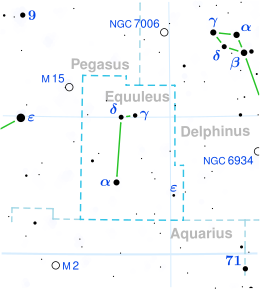Alpha Equulei
| Observation data EpochJ2000.0EquinoxJ2000.0 | |
|---|---|
| Constellation | Equuleus |
| Right ascension | 21h15m49.43192s[1] |
| Declination | +05° 14′ 52.2430″[1] |
| Apparent magnitude(V) | +3.919[2](4.49/4.96) |
| Characteristics | |
| Spectral type | G7III + kA3hA4mA9[3] |
| U−Bcolor index | +0.284[2] |
| B−Vcolor index | +0.529[2] |
| Astrometry | |
| Radial velocity(Rv) | −15.71 ± 0.05[3]km/s |
| Proper motion(μ) | RA:+59.88 ± 0.23[1]mas/yr Dec.:−94.09 ± 0.18[1]mas/yr |
| Parallax(π) | 17.14 ± 0.21mas[1] |
| Distance | 190 ± 2ly (58.3 ± 0.7pc) |
| Absolute magnitude(MV) | +0.17 (0.71 + 1.18)[3] |
| Orbit[3] | |
| Period(P) | 98.8098 days |
| Eccentricity(e) | 0 |
| Semi-amplitude(K1) (primary) | 16.34 ± 0.07 km/s |
| Semi-amplitude(K2) (secondary) | 17.9 ± 0.3 km/s |
| Details | |
| A | |
| Mass | 2.3[3]M☉ |
| Radius | 9.2[3]R☉ |
| Luminosity | 52.5[3]L☉ |
| Temperature | 5,100[3]K |
| Rotational velocity(vsini) | 20.0[4]km/s |
| B | |
| Mass | 2.0[3]M☉ |
| Radius | 2.6[3]R☉ |
| Luminosity | 26.3[3]L☉ |
| Temperature | 8.150[3]K |
| Age | 740[3]Myr |
| Other designations | |
| Database references | |
| SIMBAD | data |
Alpha Equulei(α Equulei,abbreviatedAlpha Equ,α Equ), officially namedKitalpha/kɪˈtælfə/,[5][6]is astarin theconstellationofEquuleus.It is a highproper-motionstar only 190light-yearsaway.
Nomenclature
[edit]α Equulei(LatinisedtoAlpha Equulei) is the star'sBayer designation.
It bore the traditional nameKitalpha(rarelyKitel PhardorKitalphar),a contraction of theArabicname قطعة الفرسqiṭ‘a(t) al-faras— "a piece of the horse". In 2016, theInternational Astronomical Unionorganized aWorking Group on Star Names(WGSN)[7]to catalogue and standardize proper names for stars. The WGSN approved the nameKitalphafor this star on 21 August 2016 and it is now so entered in the IAU Catalog of Star Names.[6]
InChinese,Hư túc(Xū Sù), meaningEmptiness,is anasterismconsisting of Alpha Equulei andBeta Aquarii.[8]Consequently, theChinese namefor Alpha Equulei itself isHư túc nhị(Xū Sù èr,English:the Second Star of Emptiness).[9]
Properties
[edit]The overall appearance of α Equulei is aG-typegiant[10]with anapparent magnitudeof +3.92, but it is aspectroscopic binaryconsisting of two individual stars.
The primary star is a G7 giant about fifty times moreluminous than the Sun.It has an effective temperature of5,100Kand aradiusof 9.2 times greater than the Sun.
The secondary is anA-typedwarfabout 26 times as luminous as the sun. It has an effective temperature of 8,150 K and a radius 2.6 times greater than the sun. It is achemically peculiarAm star.[3]
The two stars revolve in a circular orbit every 98.8 days. Their respective orbital velocities allow their masses to be calculated at 2.3M☉and 2.0M☉,respectively.[3]
References
[edit]- ^abcdevan Leeuwen, F. (2007)."Validation of the new Hipparcos reduction".Astronomy and Astrophysics.474(2): 653–664.arXiv:0708.1752.Bibcode:2007A&A...474..653V.doi:10.1051/0004-6361:20078357.S2CID18759600.Vizier catalog entry
- ^abcCousins, A. W. J. (1984). "Standardization of Broadband Photometry of Equatorial Standards".South African Astronomical Observatory Circulars.8:59.Bibcode:1984SAAOC...8...59C.
- ^abcdefghijklmnoGriffin, R. E. M.; Griffin, R. F. (2002)."Composite spectra Paper 11: α Equulei, an astrometric binary with an Am secondary".Monthly Notices of the Royal Astronomical Society.330(2): 288.Bibcode:2002MNRAS.330..288G.doi:10.1046/j.1365-8711.2002.05030.x.
- ^Pizzolato, N.; Maggio, A.; Sciortino, S. (September 2000), "Evolution of X-ray activity of 1-3 Msun late-type stars in early post-main-sequence phases",Astronomy and Astrophysics,361:614–628,Bibcode:2000A&A...361..614P
- ^Kunitzsch, Paul; Smart, Tim (2006).A Dictionary of Modern star Names: A Short Guide to 254 Star Names and Their Derivations(2nd rev. ed.). Cambridge, Massachusetts: Sky Pub.ISBN978-1-931559-44-7.
- ^ab"IAU Catalog of Star Names".Retrieved28 July2016.
- ^IAU Working Group on Star Names (WGSN),International Astronomical Union,retrieved22 May2016.
- ^(in Chinese)Trung quốc tinh tọa thần thoại,written by trần cửu kim. Published by đài loan thư phòng xuất bản hữu hạn công tư, 2005,ISBN978-986-7332-25-7.
- ^(in Chinese)Hương cảng thái không quán - nghiên cứu tư nguyên - lượng tinh trung anh đối chiếu biểuArchived2011-01-29 at theWayback Machine,Hong Kong Space Museum. Accessed on line November 23, 2010.
- ^Ginestet, N.; Carquillat, J. M.; Jaschek, C. (1999)."Spectral classifications in the near infrared of stars with composite spectra. III. Study of a sample of 137 objects with the Aurelie spectrograph".Astronomy and Astrophysics Supplement.134(3): 473.Bibcode:1999A&AS..134..473G.doi:10.1051/aas:1999444.

